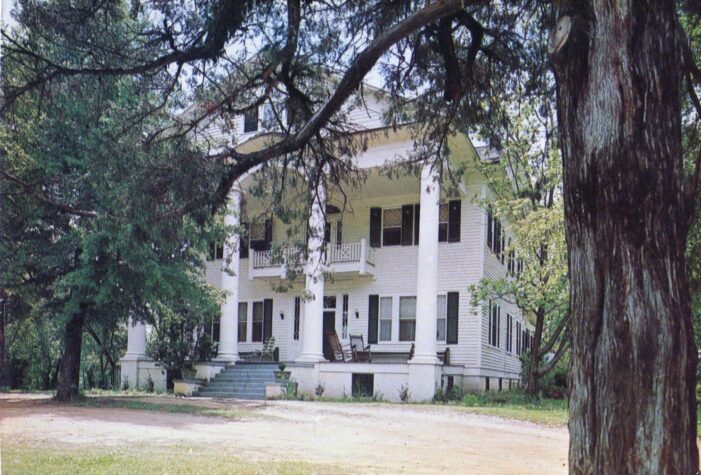Edgefield County’s rich historical heritage will be showcased in a tour of eight special places scheduled for Friday and Saturday, Oct. 20-21.
Friday’s tour, from 5-8 p.m. will be candlelit. Saturday’s tour will be 1-4 p.m. Tickets are $40 and can be purchased in advance or the day of the tour by visiting the Discovery Center, 401 Main St., or calling (803) 637-2233.
The tour will include a live demonstration by the Village Blacksmith and a first-ever look at Jackson Oaks.
Descriptions of homes:
- BROOKS-TOMPKINS HOUSE, 609 Buncombe Street. This house was built circa 1820 by Waddy Thompson, Jr. (1798-1868), who would later become a Congressman and the United States Minister to Mexico. In 1824 he sold the house to his wife’s first cousin, Whitfield Brooks (1790-1851), a prominent lawyer and Commissioner of Equity of the Edgefield District. Brooks’ eldest child, Preston S. Brooks (1819-1857), who became a Congressman and who attained national fame in 1856 when he caned Sen. Charles Sumner on the floor of the U.S. Senate, grew up here. After his parents retired to their country plantation in 1849, Preston moved back into the house with his family. The home was later purchased by Rev. Luther Gwaltney (1830-1910), the well-known Baptist minister, who lived there for some years. Around the turn of the 20th century, the house was purchased by Dr. James Glover Tompkins (1858-1938), a prominent local physician, whose family has continued to own it until the present time. In 1924 the house was partially burned but was rebuilt for Dr. Tompkins by W. S. G. Heath (1868-1952), using many of the architectural adornments of the original house, including mantelpieces, wainscotings and fanlights. The elaborate carvings are of an unusual style in Edgefield, found in only one other house,Holmewood.
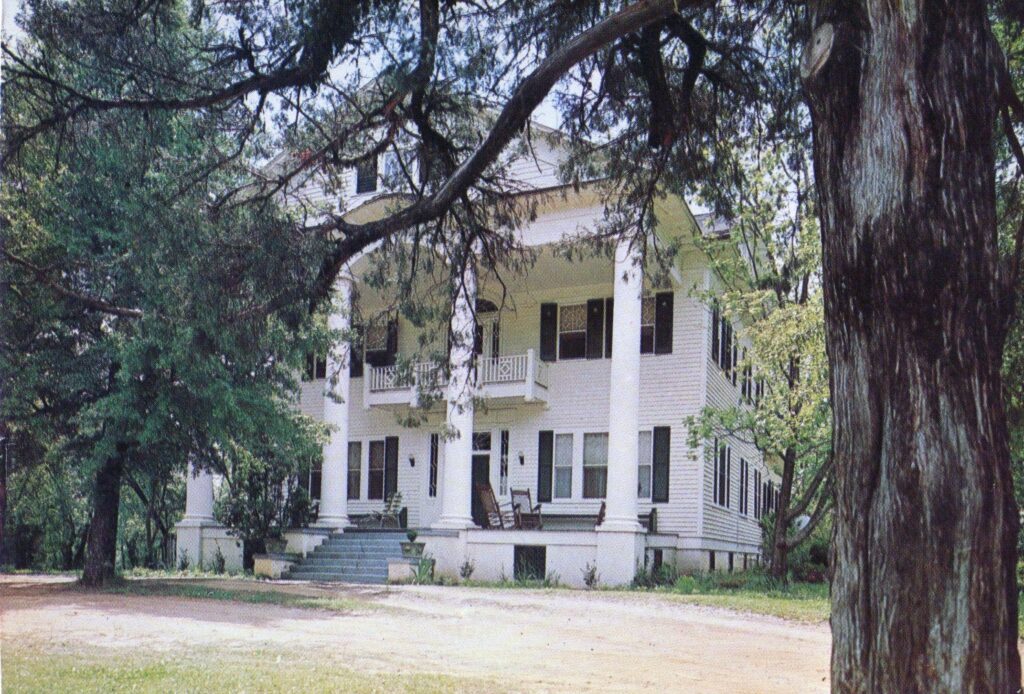
2. DEAD PIRATES’ FORGE WITH JAKE JACOBSEN, Village Blacksmith, 206 Jeter Street. This building was built as a blacksmith shop in 1917 by Bettis Cantelou (1871-1957), a longtime Edgefield businessman who owned a livery stable business across the street where the Magistrates’ building now stands. At one time there were many blacksmith shops located in and around the Town of Edgefield. In the days before automobiles, blacksmiths were essential to the economy, keeping horses and mules shod, repairing wagons and plows and making numerous items required for the agricultural economy. Many of the blacksmith shops, like this one, were operated in conjunction with a livery stable where horses and mules could be stabled while their owners tended to their business in the Town. For many years the blacksmith here was McKinley Oliphant (1898-1967), a courtly African American artisan. At the time of “Kinley’s” death in 1967, the Edgefield Advertiser editorialized: “Someday there should be – and probably will be – a modest monument erected to Edgefield’s last blacksmith who had a humility, a courtesy and above all an innate sense of wanting to help whenever he could . . .” The shop closed after McKinley’s death but was re-opened as a living history project in 2000 by the Edgefield County Historical Society. Today, the Village Blacksmith, owned and operated by Jake Jacobson, using the tools and technology of a century ago, produces artistic reproductions of items of long ago. Many items are for purchase, but the blacksmith also accepts commissions for custom works.
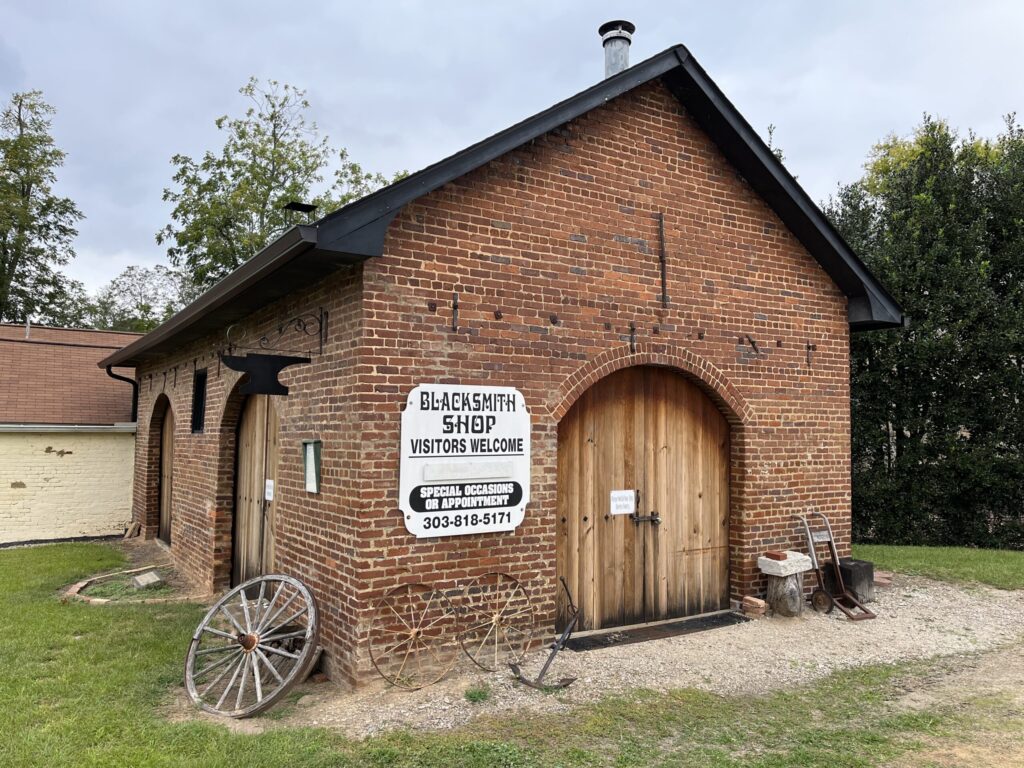
3. EDWIN FOLK HOUSE, 501 Buncombe Street. Originally built in 1890 by W. J. McKerall as a one-story dwelling, this house was bought by Edwin H. Folk (1863-1940) in 1895 and substantially enlarged with a second story. A native of the far eastern side of the Edgefield District near Batesburg, Folk studied law at the University of Virginia. He came to Edgefield in 1887 to practice law where he formed a partnership with his brother, William H. Folk (1852-1895). Early in his career, he was made captain of the Edgefield Rifles, a local militia company, and was thereafter known as “Captain Folk.” He practiced law in Edgefield for fifty-two years until his death in 1940. Edwin Folk was a great lover of Camellias and had over 500 varieties at his home. One camellia was so tall that he was able to pick a bloom from his second-story bedroom window. He was also devoted to improving education in Edgefield County, serving on the school board for nearly half a century. After his death, the house continued to be occupied by his school-teacher daughter, Ida Folk (1899-1961) and his lawyer son, J. Raymond Folk (1904-1977). It is now being restored by its current owner.
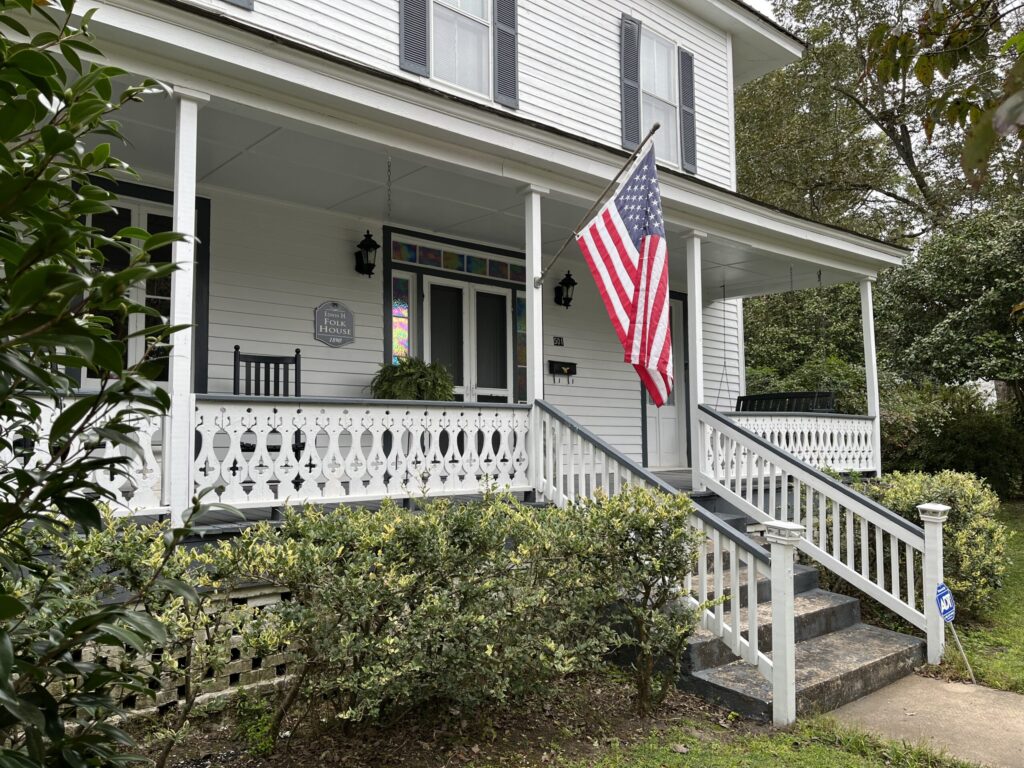
4. DISCOVERY CENTER MUSEUM & THEATRE, 405 Main Street. The Joanne T. Rainsford Discovery Center was built in 1840 by Captain James Miller, a wealthy planter and captain of an Edgefield militia company. It was moved in 1992 from its original location some seven miles south of Edgefield on U.S. Highway 25 to its Main Street location in Edgefield. The original house, prior to being moved, had heavy plaster moldings, unique painted designs on the ceilings and a second-floor ballroom. When reconstructed after its move to Edgefield, the ballroom was not reproduced and changes were made to make the house more suitable for a museum. The house, which had been known as “Magnolia Grove” prior to its removal, was renamed in memory of Joanne T. Rainsford (1949-1997), the president of the Edgefield County Historical Society and one of the founders of the South Carolina National Heritage Corridor. In 2010, the eastern wing of the Discovery Center was converted into the William Miller Bouknight Theatre, a black box theatre where the Society sponsors theatrical productions.
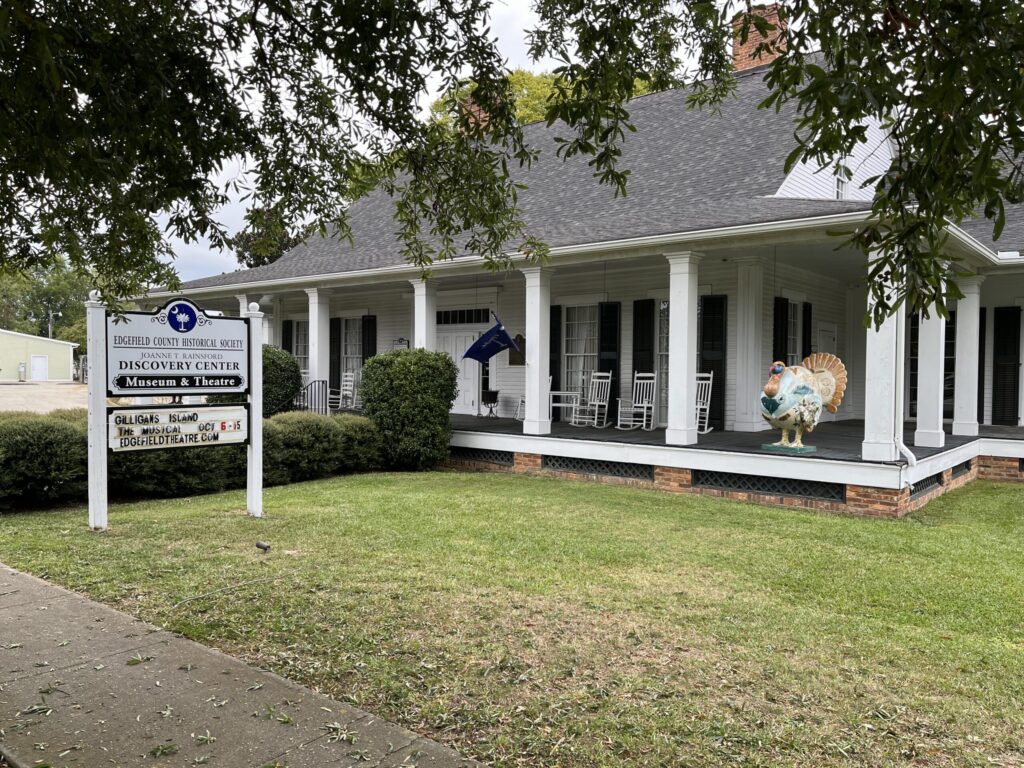
5. MAGNOLIA DALE HOUSE MUSEUM, 320 Norris Street. This house is located on the site of the first residence in Edgefield built by Peter Youngblood circa 1762. The property was later the home of Erasmus J. Youngblood who sold it after the house burned in 1843 to Samuel Brooks of Connecticut. It is thought that Brooks built the core of the present house as early as 1843. In 1873 Brooks’ daughter sold the property to Alfred J. Norris, a prominent lawyer and businessman, who engaged Anton Markert to enlarge the house. Many of Markert’s signature architectural features are incorporated in the structure. In 1875 Norris’s only daughter, Mamie, was born here. She married James Hammond Tillman (1868-1911) who became Lieutenant Governor of South Carolina in 1896. In 1929 the house was sold to the Kendall Company, but Mrs. Tillman continued to live here. In 1959 she prevailed upon the Company to give the property to the Edgefield County Historical Society. Today the house is the house museum of the Society and is open by appointment. Interesting artifacts in the house include portraits of Arthur Simkins (1742-1826), his wife Margaret Matthews Dalby, Edmund Bacon (1776-1826), his wife Eliza Fox, and the daughters of Francis Pickens, a sideboard belonging to Governor George McDuffie, the dining room table of Governor and Senator Benjamin Ryan Tillman and many interesting items in the Strom Thurmond Room. At his death in 2006, Edgefield’s beloved character, Broadus M. Turner, left a substantial bequest to the Society for the restoration of the house.
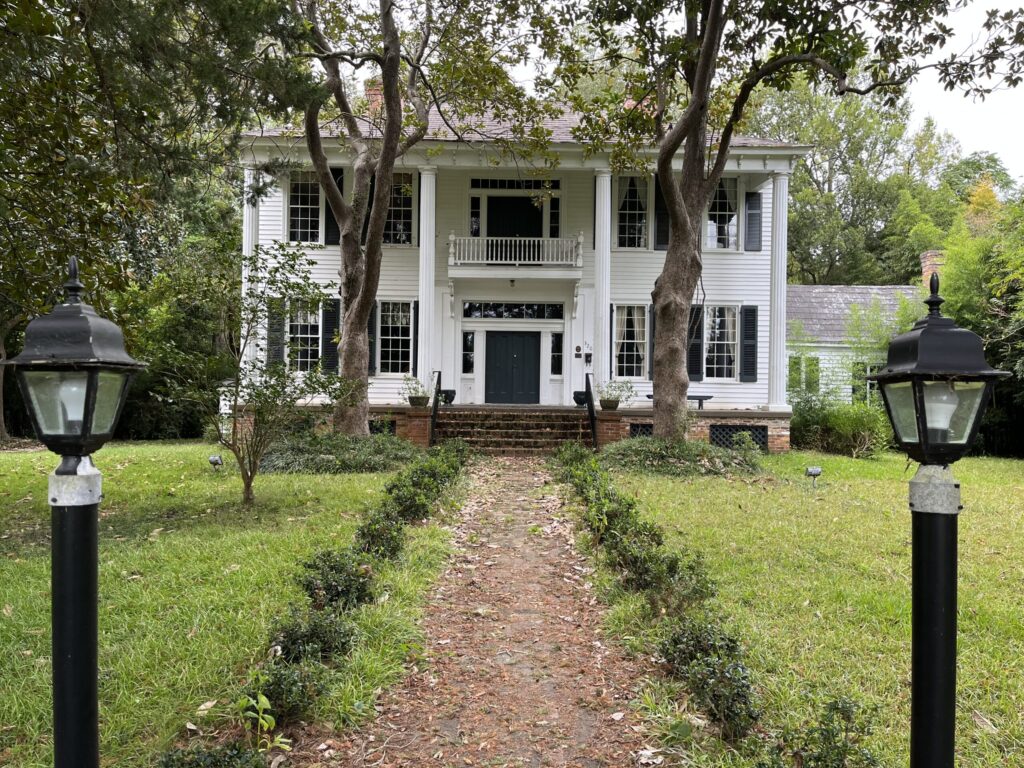
6. TRINITY CHURCH, EDGEFIELD, 315 Simkins Street. This church was organized in 1835, and the building was completed in 1836. It was a classical building with Palladian windows and a portico on the front. In 1886 the Victorian church tower was built, eliminating the original portico. Unfortunately, no photographs or descriptions of the original portico have survived. In 1951 the upper portion of the tower was replaced by the present steeple. Among the original leaders of the church were Whitfield Brooks and his wife, Mary Parsons Carroll Brooks, James Parsons Carroll, Francis Pickens, Andrew Pickens Butler, Francis Hugh Wardlaw and Edmund B. Bacon. Significant memorials in the church include stained glass windows to Edward Tabb Walker, a longtime rector, and James T. Bacon, longtime newspaper editor and organist at the church, marble tablets to Whitfield Brooks, prominent lawyer and planter, Whitfield Butler Brooks, a valiant soldier who died in the War with Mexico, and Francis Butler Simkins, one of the greatest Southern historians of all times, and a baptismal font to the daughters of James Parsons Carroll.
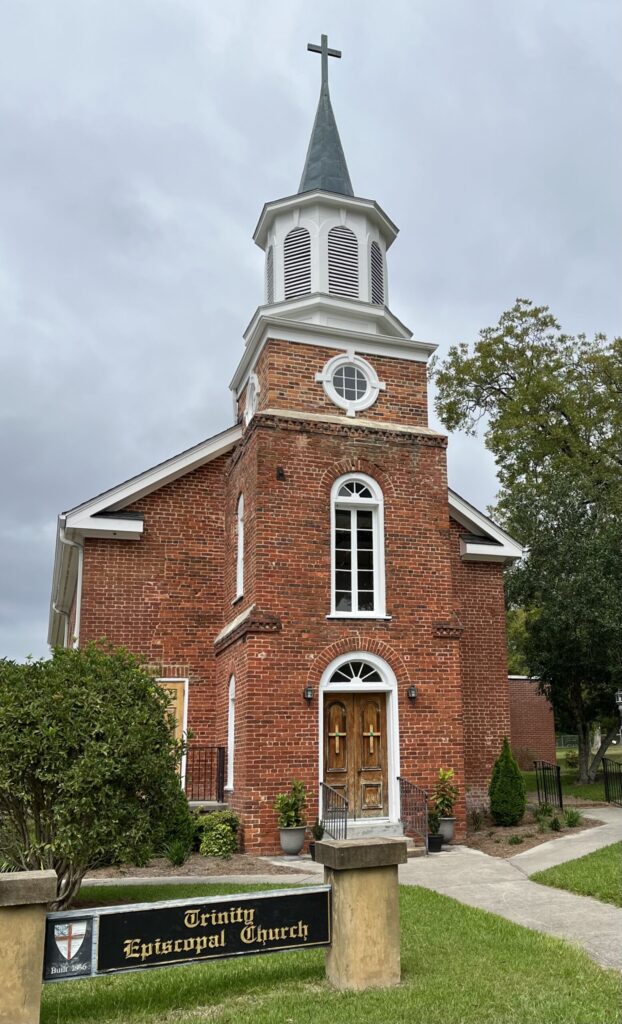
7. AUGUST & HOUSE, THE ISRAEL MUKASHY BUILDING, 102 Courthouse Square. Prior to the fire of 1881, this was the site of the store and barroom of A. A. Clisby (1848-1916) where the infamous Booth-Toney Shootout of 1878 occurred. The present building was built in 1891 by James M. Cobb (1849-1912), a longtime Edgefield merchant. Cobb had operated a dry goods business in Edgefield as early as 1870 and continued in business well into the 20th century. Israel Mukashy (1882-1964), a Jewish merchant who had emigrated from Russia in 1905, occupied this building for many years. Originally a peddler operating out of Augusta, Mukashy moved to this location in 1920. He lived in Edgefield with his wife, Mrs. Kate R. Marcus Mukashy until his death in 1964. Much beloved in Edgefield, Mr. and Mrs. Mukashy were affectionately known as “Mr. & Mrs. Muk.” In 1950 the Mukashy Department Store was sold to Mr. Joseph Vigodsky of Greenville and was operated under the name “Carolina Sales.” At that time, it came under the management of Mr. Archie E. Keesley, Sr. (1926-2000). Mr. Keesley operated the store for nearly a half century until his retirement in 1999. In 2020, this became the retail shop of August and House, a novelty shop offering apparel and gifts, “Creative. Raw + Refined,” as well as ice cream.
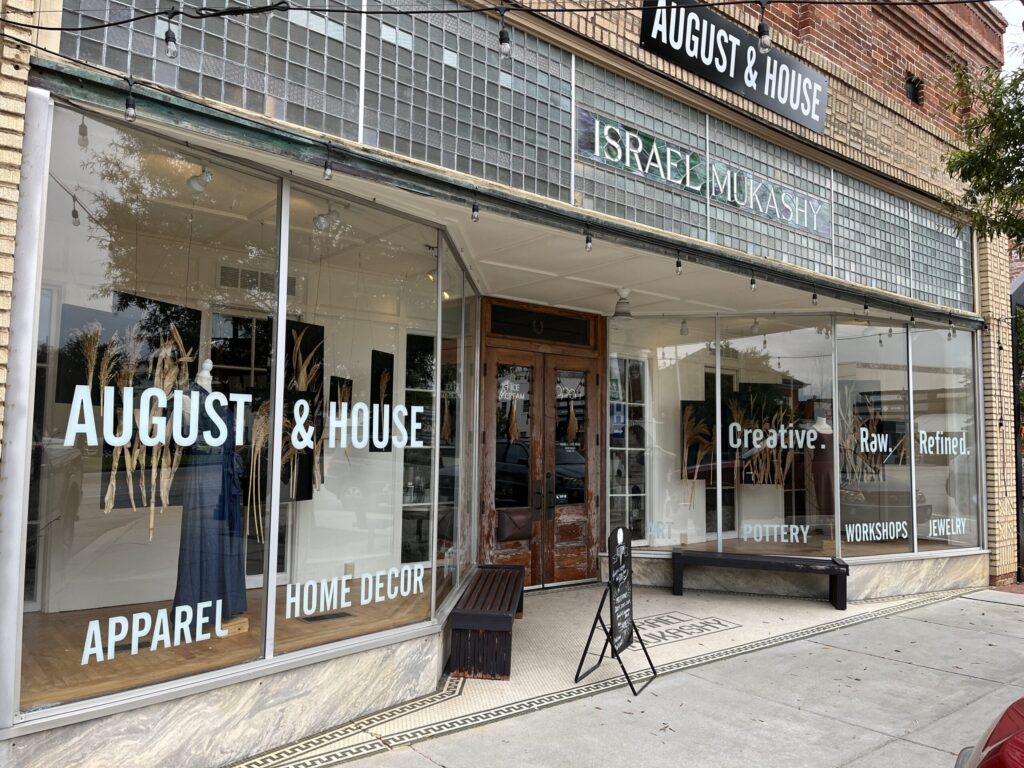
8. JACKSON OAKS, 1247 Augusta Road, Trenton. This house was originally built in 1835 by Thomas Ross McKie (1805-1867) in what was called the Woodlawn section of the Edgefield District near present-day Clark’s Hill on the Savannah River. It later became the home of his son, Dr. Thomas Jefferson McKie (1828-1898), one of the foremost physicians of this area and a one-time president of the South Carolina Medical Association. Dr. McKie was also a substantial contributor to The History of Edgefield County (1897) by John R. Abney. In 1969, Mr. & Mrs. Clyde Reel (Betty Wise) Jackson, III of Edgefield purchased the house, dismantled it board-by-board, moved it to its current site and re-erected it. In doing so, they made appropriate changes to make it more convenient, but were careful to preserve the wonderful architectural features which make this one of the most significant historic houses of Edgefield County. One addition which they made were the columns from “Evergreen,” the house which was on Main Street in Edgefield where the police and fire department now stands, sometimes referred to as the Gantt-Cantelou house which they acquired when that house was demolished by the Town. The Jacksons also planted the wonderful avenue of live oak trees from which the house derives its name. This tour is the first time that this house has been on an Edgefield tour.
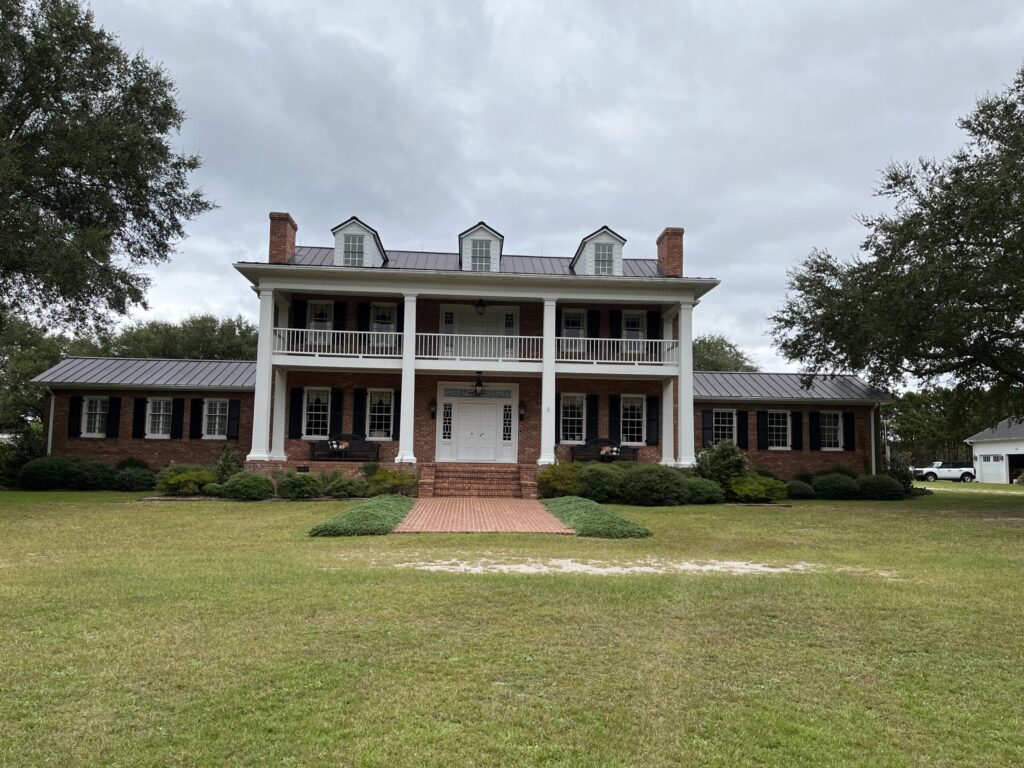
James Folker
237 Woodridge Road
Edgefield, S.C. 29824
(706) 340-0116

